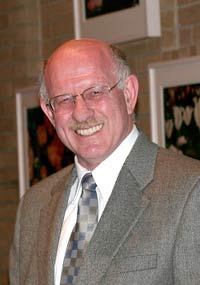
Handy Links
SLAC News Center
SLAC Today
- Subscribe
- Archives: Feb 2006-May 20, 2011
- Archives: May 23, 2011 and later
- Submit Feedback or Story Ideas
- About SLAC Today
SLAC News
Lab News
- Interactions
- Lightsources.org
- ILC NewsLine
- Int'l Science Grid This Week
- Fermilab Today
- Berkeley Lab News
- @brookhaven TODAY
- DOE Pulse
- CERN Courier
- DESY inForm
- US / LHC
SLAC Links
- Emergency
- Safety
- Policy Repository
- Site Entry Form

- Site Maps
- M & O Review
- Computing Status & Calendar
- SLAC Colloquium
- SLACspeak
- SLACspace
- SLAC Logo
- Café Menu
- Flea Market
- Web E-mail
- Marguerite Shuttle
- Discount Commuter Passes
-
Award Reporting Form
- SPIRES
- SciDoc
- Activity Groups
- Library
Stanford
Around the Bay
Dorfan Today: Félicitations au LAL
 Accelerator-based science is possibly the most collaborative of all the major fields of "big"
science. Competition to be the "discoverer" rather than the "validator" is
both healthy and a key
ingredient for producing outstanding science. Notwithstanding this often very intense competition,
laboratories, detector collaborations and individuals openly share detailed information on new
concepts, novel ideas their development and optimization across the full spectrum of research tools.
Accelerator-based science is possibly the most collaborative of all the major fields of "big"
science. Competition to be the "discoverer" rather than the "validator" is
both healthy and a key
ingredient for producing outstanding science. Notwithstanding this often very intense competition,
laboratories, detector collaborations and individuals openly share detailed information on new
concepts, novel ideas their development and optimization across the full spectrum of research tools.
So it is for several SLAC programs. While BaBar and Belle compete to discover new physics before the other, PEP-II and KEKB help each other on a continuous basis, sharing what each learns about machine performance or helping each other to maximize future improvements or fix known problems. In addition, our highly experienced SSRL staff is often involved in helping with the design, implementation or improvements of other synchrotron light sources worldwide, all of which compete for very similar scientific "prizes."
The "openness in research" principle is what underlies this noble behavior. But this principle goes beyond protecting and promoting appropriate behavior, because by maintaining such close working relationships, we are able to learn from each other and ultimately realize big scientific dreams more effectively and more quickly. In some cases we achieve important outcomes that would otherwise never happen. It comes down to relationships—trust relationships between institutions and individuals within those institutions. Cultivating and nurturing such relationships is an essential part of what the accelerator-based community has done so well this past half-century and what it must continue to do if we are to thrive as we have.
And so it was a great privilege for me to attend the 50th anniversary of LAL, Laboratoire de l'accelérateur linéaire, which is situated just outside Paris in Orsay, and to bring warm congratulations to them from the SLAC community. The similarities between the LAL and SLAC laboratories are many: both were birthed by a prominent academic institution (Ecole Normale Superior in LAL's case), both have been pioneers in electron linacs and storage rings and both have had long-term programs in particle physics and synchrotron light. We have had an ongoing relationship for the full 50 years of LAL's existence.
The beginning of that relationship was a post-doctoral visit in the late 1950's by our own Dick Taylor, who was then a freshly minted Stanford PhD. Dick and Rita also attended this week's celebration. Dick recounted the excitement and challenges of those early years when LAL was completing and commissioning its first linac and spectrometer, and beginning their particle physics experimental program. Dick, of course, returned to Stanford to help build SLAC and the End Station A spectrometers, soon thereafter to perform the research that won him the Nobel Prize for the discovery of quarks.
With the help of Greg Loew and many others, I was able to present a chronicle of LAL-SLAC collaboration for the period from the early 1960's until now. It has been a rich history of long- and short-term visits and exchanges which cemented professional relationships and friendships that led to the development of many bold ideas and practical solutions to very challenging linac, storage-ring and detector problems. At the same time, a lot of collaborative science was done and future leaders were "bred." Three of the last four Directors of LAL spent significant parts of their formative years at SLAC. Michel Davier worked at SLAC as an Orsay student with the late Robert Mozley, returning later in 1971-75 as an Assistant and Associate Professor in David Leith's group. Francois Richard was a research assistant also in the Leith Group in the mid 1970's. The current LAL Director, Guy Wormser, was my postdoc in Group C in the late 1980s, working on the MARK II at SLC. Guy and I have worked together continuously since that visit on the B Factory machine, detector and physics programs, on the ILC and on many international committees.
The history lesson was very informative for me, I hope for you too. Vive la collaboration!
—Jonathan Dorfan
SLAC Today, June 12, 2006